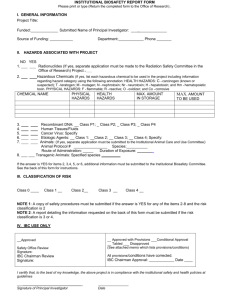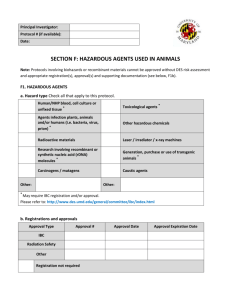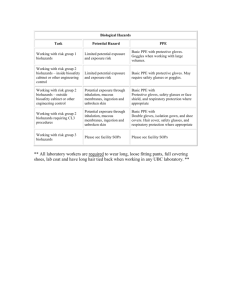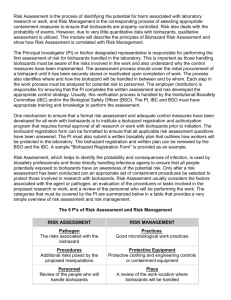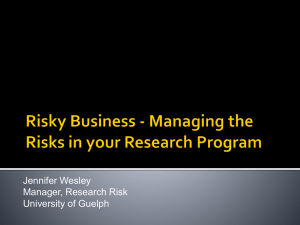LABORATORY ANIMAL HEALTH MANAGEMENT
advertisement
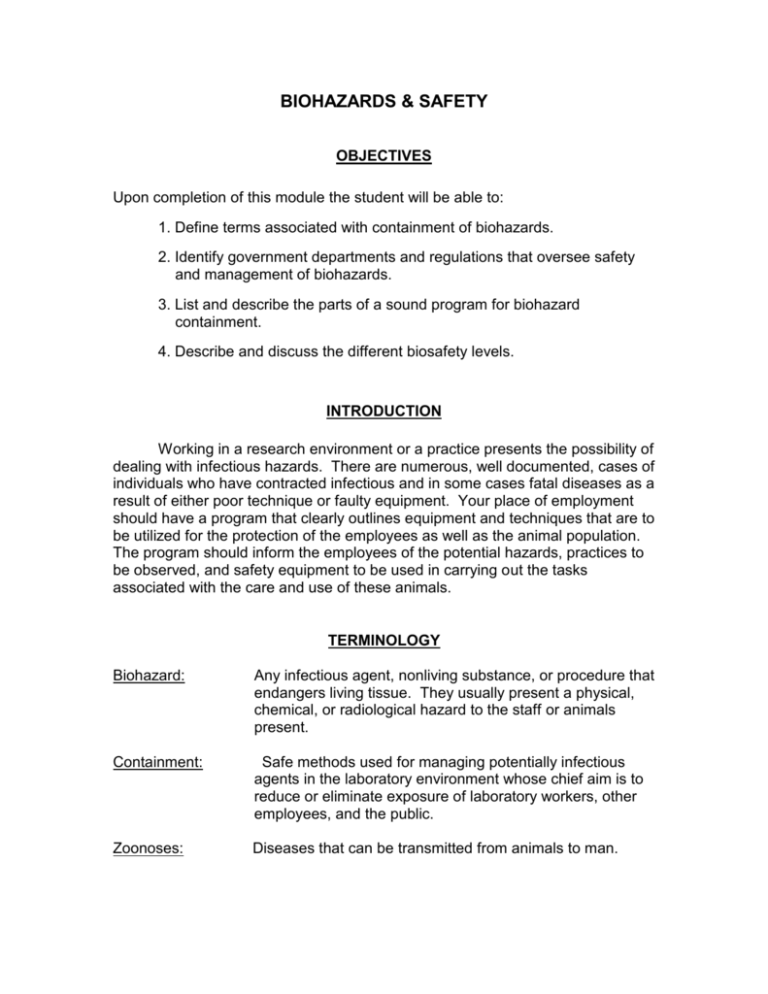
BIOHAZARDS & SAFETY OBJECTIVES Upon completion of this module the student will be able to: 1. Define terms associated with containment of biohazards. 2. Identify government departments and regulations that oversee safety and management of biohazards. 3. List and describe the parts of a sound program for biohazard containment. 4. Describe and discuss the different biosafety levels. INTRODUCTION Working in a research environment or a practice presents the possibility of dealing with infectious hazards. There are numerous, well documented, cases of individuals who have contracted infectious and in some cases fatal diseases as a result of either poor technique or faulty equipment. Your place of employment should have a program that clearly outlines equipment and techniques that are to be utilized for the protection of the employees as well as the animal population. The program should inform the employees of the potential hazards, practices to be observed, and safety equipment to be used in carrying out the tasks associated with the care and use of these animals. TERMINOLOGY Biohazard: Any infectious agent, nonliving substance, or procedure that endangers living tissue. They usually present a physical, chemical, or radiological hazard to the staff or animals present. Containment: Safe methods used for managing potentially infectious agents in the laboratory environment whose chief aim is to reduce or eliminate exposure of laboratory workers, other employees, and the public. Zoonoses: Diseases that can be transmitted from animals to man. TYPES OF BIOHAZARDS Hazardous agents are substances that present physical, chemical, or radiological risk to humans or animals. They are categorized as follows: Radioisotopes: Radioactive forms of normally non-radioactive elements. They emit low levels of radiation, which makes them valuable as tracers in biological investigations of metabolic processes. Usually they are only dangerous when contacted directly. Pathogens: These are live infectious bacteria, viruses, fungi, or parasites that pose a threat health wise to humans and animals. Mutagens: These are substances that cause changes in chromosomes and thereby induce the occurrence of mutations. Examples are high doses of X-rays and some chemicals. Toxins: These are poisonous substances produced by bacterial, plant, or animal cells. An example is the castor bean plant that produces a toxin known as ricin or some of the molds that develop on corn after a particular wet growing season. AGENCIES CONCERNED WITH SAFETY AND BIOHAZARDS There are a plethora of government agencies, rules, and regulations well meant to protect you in the work place. Some of the more prominent ones are: Occupational Safety and Health Administration OSHA The regulations are applied to all work places and cover fire, electrical, and mechanical safety and exposure to chemicals, radiation, and noise. Environmental Protection Agency EPA The EPA has promulgated rules, which apply to laboratories. The Resource Conservation and Recovery Act (RCRA) has jurisdiction over disposal of waste products. The Toxic Substance Control Act controlling public exposure to chemicals and the Medical Waste Tracking Act of 1988 oversees treatment, tracking, and disposal of medical wastes are enforced by the EPA. 2 Office of Laboratory Animal Welfare OLAW Develops and monitors, as well as exercises compliance oversight relative to the Public Health Service (PHS) Policy on Humane Care and Use of Laboratory Animals involved in research conducted or supported by any component of the Public Health Service HAZARD CONTAINMENT A sound program of biohazard containment has at least the following elements: Education Occupational Health Program Laboratory Practice, Procedures, and Technique Safety Equipment Facility Design To contain biohazards, these practices should be observed and utilized: 1. Ventilation systems that direct airflow to either be positive or negative. 2. Ventilation systems that use filtration of incoming and exhausted air. 3. Buildings that have air lock systems or pass-through autoclaves to separate clean and dirty areas. 4. Ultraviolet light barriers at points of entry throughout the building. 5. Locker rooms for changing and showering. 6. Intercom systems for communication between clean and dirty areas. 7. Treatment of contaminated waste. 8. The use of back-flow check valves within the water supply system. 9. Separation of hazardous areas and utility systems. 10. The use of standard operating procedures for all operations throughout the facility. 3 Read the following website for Biosafety Level explanation. http://www.cdc.gov/od/ohs/biosfty/bmbl4/bmbl4s2.htm 4
